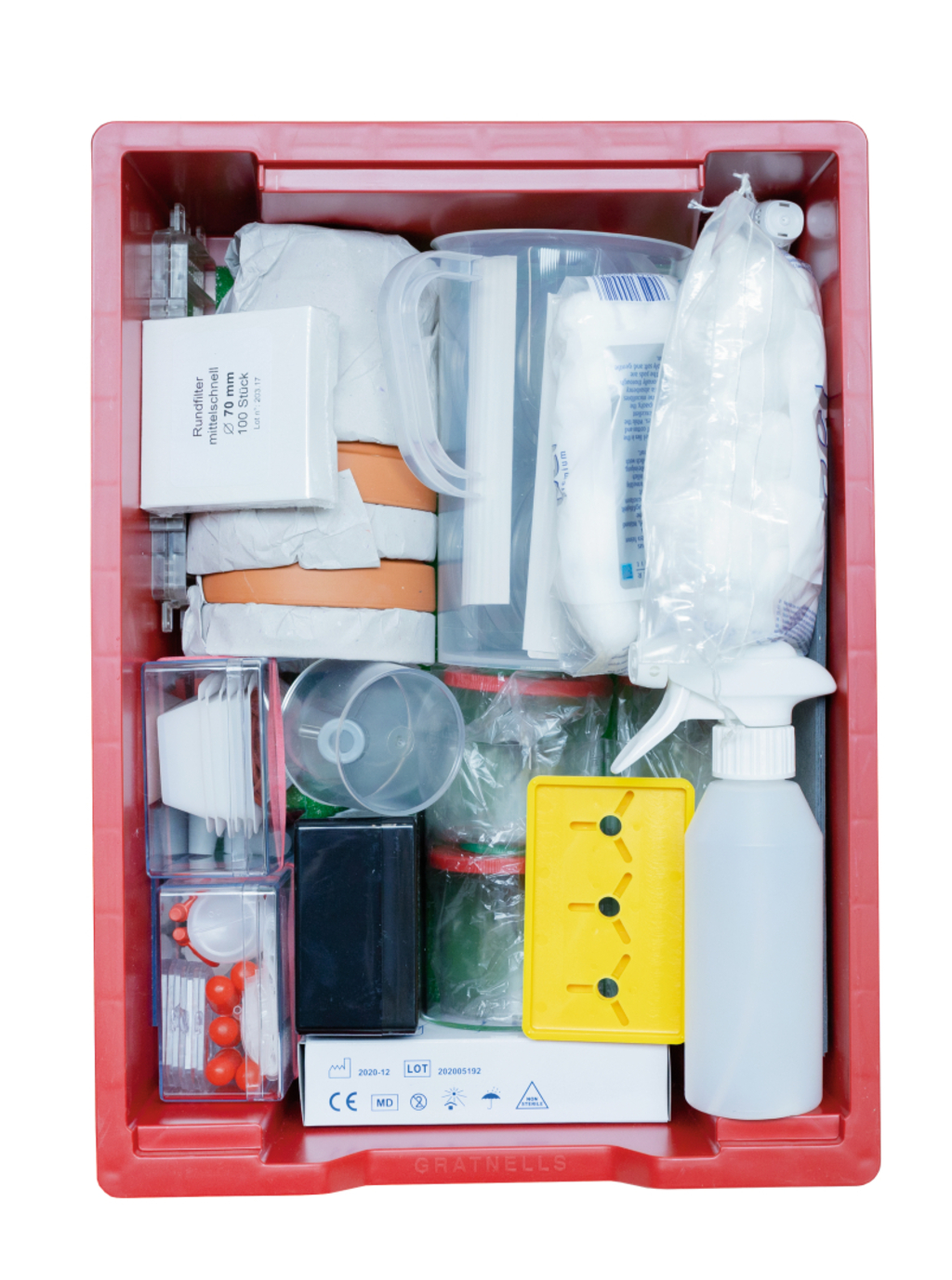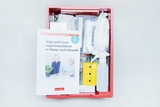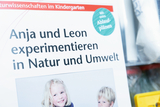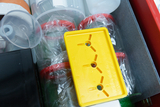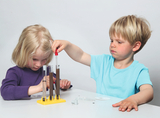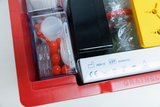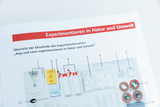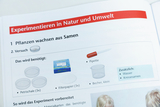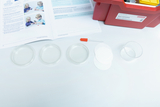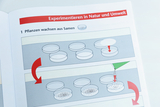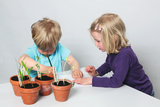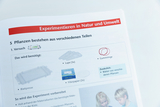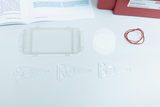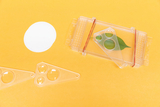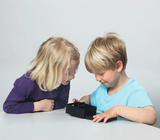Kindergarten kit Anna and Leon experiment in nature and environment
On the trail of nature
The topics of nature and environment are among the most important in pre-school life. The ‘Nature and environment’ box contains over 30 exciting
experiments to enthuse children into thinking about their environment.
They illustrate the interaction between plants, animals, people and non-living aspects of nature. Children experience that it is important to protect the environment and that they too have the opportunity to do so.
Trips can be taken to observe nature and children can simultaneously be given research tasks such as collecting plants, stones or animals for subsequent investigation. They can keep the results of this research in their own files, take pictures of what they find or make a collection. All the results can be exhibited in the kindergarten.
The children should be introduced to the following findings with the help of the experiment:
- Most plants develop from a seed.
- This seed contains the plant's genetic information.
- In order to germinate, the seed requires certain environmental conditions.
Time period: approx. 2-3 days
The children should be introduced to the following findings with the help of the experiment:
- Plants need a clean environment to grow and live properly.
- If pollutants are introduced into the air, soil or water, this worsens the living conditions of the plants, and thus also their growth.
Period: approx. 2-3 days
The children should be introduced to the following findings with the help of the experiment:
- Plants germinate and grow at different rates.
- There is a great variety of plants that differ in shape, color and size.
- A single seed develops into a whole plant, with leaves and flowers.
- Some plants develop fruits that humans can eat.
Period: about 8-10 days
The children should be introduced to the following findings with the help of the experiment:
- Plants are made up of different parts that perform different tasks, e.g. transporting water.
- Individual components can be extracted from the plant, e.g. dyes, fragrances or oils.
- With the help of the veins, the plant transports water and nutrients from the roots to all parts of the plant.
- The roots give the plants support underground and supply them with nutrients and water from the soil.
The children should be introduced to the following findings with the help of the experiment:
- Animals live in different biotopes, habitats.
- There are animals in almost every area of the earth.
- Animals adapt to the living conditions of the environment.
- Humans can help animals to conquer habitats.
The children should be introduced to the following findings with the help of the experiment:
- Soil consists of different components.
- Soil can occur in different compositions of the components, there is fertile potting soil, but also sandy or poor soil.
- The storage capacity of the individual soil depends, among other things, on its composition and plant growth.
The children should be introduced to the following findings with the help of the experiment:
- Plants and animals need certain environmental conditions to survive.
- Animals adapt to the circumstances or look for the better habitat by migration.
The children should be introduced to the following findings with the help of the experiment:
- In nature, everything is part of the cycle of life.
- Dead plant parts and animals rot, which means they are decomposed by fungi and bacteria. In this way, they re-enter the cycle of nature: They become new soil, which again serves as the basis for new life.
- The rotting process depends on various environmental conditions and time.
The children should be introduced to the following findings with the help of the experiment:
- There are different weather conditions.
- The weather is strongly determined by the season.
- Living things adapt to the seasons. Plants and some animals hibernate in winter.
The children should be introduced to the following findings with the help of the experiment:
- Plants are formed not only from seeds, but also from cuttings, cuttings and bulbs.
- Parts of the roots are able to form a plant again.
The children should be introduced to the following findings with the help of the experiment:
- Most plants need light to grow.
- Plants grow towards the sun or towards a light source.
- Plants do not grow at all or only puny if there is a lack of light.
Time period: approx. 5 days
The children should be introduced to the following findings with the help of the experiment:
- There are a large number of living organisms in the soil that cannot be seen at first glance.
- Different types of soil provide different habitats for animals and plants.
- There is a dependency between animals and plants.
The children should be introduced to the following findings with the help of the experiment:
- Animals live in different biotopes, habitats.
- There are animals in almost every area of the earth.
- Animals adapt to the living conditions of the environment.
- Humans can help animals to conquer habitats.
The children should be introduced to the following findings with the help of the experiment:
- Living nature depends on the weather, depending on the weather conditions it can develop.
- The growth of plants depends on the environmental conditions that surround them.
- Almost all living things need water, air, light and heat to live.
The children should be introduced to the following findings with the help of the experiment:
- In nature, there is a cycle that constantly triggers the processes.
- There is the water cycle, on which all life on earth depends to some extent.
- Seasons determine the life of many living things.
- 2 × Beaker, plastic 500 ml
- 4 × Beaker w. magnifying lens
- 2 × Felt-board, 350x255 mm
- 6 × Rubber stopper 15/11mm
- 1 × Spatula, wood, 100 pcs.
- 1 × Screen translucent, plastic 90x90x1 mm
- 1 × Beaker, plastic 125 ml, graduated
- 2 × Plastic box 105x90x50 mm
- 6 × Plastic dish 95x62x20 mm
- 1 × Ruler 30 cm, plastic
- 1 × Measure, 1000ml
- 1 × Metal spoon, 138 mm
- 1 × Powder funnel, PP, 80 mm
- 1 × Filter paper, circular 70 mmØ, 100 pcs.
- 1 × Lidfoam grey,515x355x10mm
- 2 × Spray bottle
- 2 × Thermometer, student type–25 to +50°C
- 1 × Set (5) clay pots
- 3 × Dropping bottle, PE 20 ml
- 1 × Cotton Balls
- 1 ×
- 4 ×
- 1 × Storing tray, deep, red
- 2 × Air-permeable set (lid)
- 3 × Triple lens magnifier
- 1 × Carton for SEG (large tray)
- 1 × Lid for 75028 + 75038
- 1 × Plastic tubing 210 mm, 6x1,5 mm
- 6 × Double dish,plastic 80 mm
- 6 × Plastic test tube, 152 mm
- 2 × Test tube stand, plastic
- 1 × Suction flask 90 ml
- 6 × Dropping pipette, plastic
- 1 ×
- 1 ×
- 1 ×
